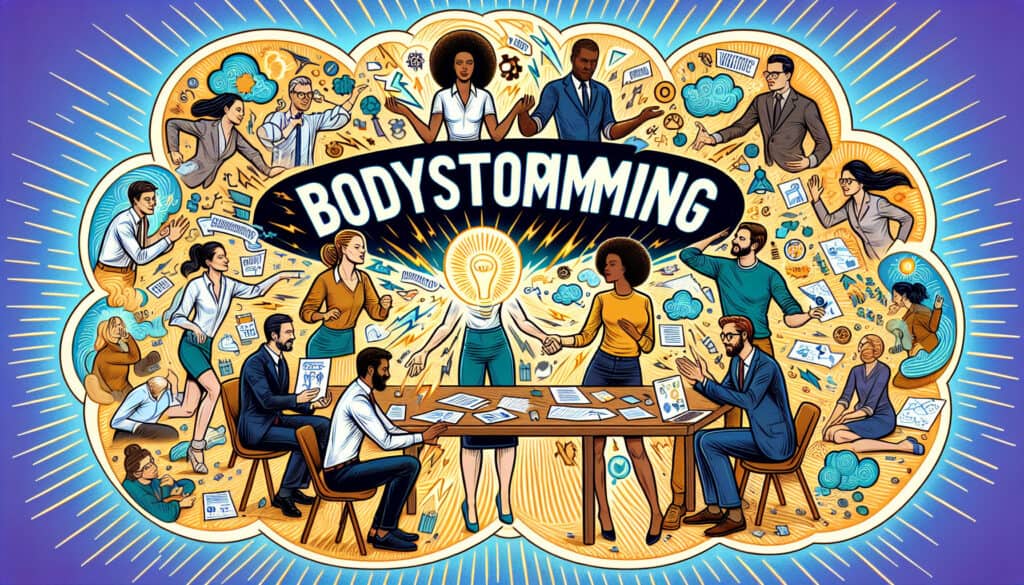A brainstorming technique that involves physically experiencing a situation to generate ideas.
- Metodologías: Clientes y marketing, Economía
Bodystorming

Bodystorming
- Lluvia de ideas, Creatividad, Pensamiento de diseño, Diseño centrado en el ser humano, Ideación, Diseño de interacción, Creación de prototipos, Experiencia de usuario (UX), Diseño centrado en el usuario
Objetivo:
Cómo se utiliza:
- In bodystorming, participants act out a scenario to gain a deeper understanding of the user experience. This can help to generate more empathetic and centrado en el usuario ideas.
Ventajas
- Provides a rich and contextualized understanding of the user experience, can lead to more innovative and user-centered ideas, and can be a fun and engaging way to brainstorm.
Contras
- Can be difficult to set up, requires a willingness from participants to be physically active and to role-play, and may not be suitable for all types of problems.
Categorías:
- Ideación, Diseño de producto
Ideal para:
- Generating user-centered ideas by physically experiencing a situation.
Bodystorming can be particularly effective in industries such as healthcare, consumer electronics, and automotive design, where understanding user interactions with products or services is paramount. During this methodology, participants may include designers, engineers, marketing teams, and actual users or stakeholders, enriching the ideation process with diverse perspectives. This approach is especially beneficial during the ideation and prototyping phases of design projects, where conventional brainstorming might fall short in capturing the realism of physical interactions or emotional responses. For instance, when designing a new dispositivo médico, team members might simulate patient-doctor interactions to highlight potential obstacles in usability, thus allowing designers to address real-world concerns proactively. This methodology encourages playful experimentation, fostering an environment where team members feel comfortable exploring unconventional ideas without the constraints of traditional brainstorming methods. Engaging in bodystorming can also enhance team cohesion, as participants share experiences and insights that can lead to unexpected solutions, making it a valuable tool in the iterative design process. As teams physically immerse themselves in user situations, the tangible experience can spark innovative thoughts that may not surface through standard abstract brainstorming sessions.
Pasos clave de esta metodología
- Identify a specific user scenario to explore.
- Assign roles to participants, ensuring diversity in perspectives.
- Act out the scenario, focusing on behaviors, emotions, and interactions.
- Encourage improvisation and spontaneous responses during the role-play.
- Observe the dynamics and take note of key interactions and reactions.
- Debrief immediately after the enactment to discuss experiences and observations.
- Brainstorm ideas and solutions based on insights gained from the enactment.
Consejos profesionales
- Encourage participants to adopt exaggerated physical movements and emotions to immerse themselves fully in the user's experience.
- Utilize props and environmental elements to simulate real-world interactions, enhancing authenticity in the scenarios.
- Incorporate targeted role-play scenarios that explore edge cases or unexpected user behaviors for deeper insights.
Leer y comparar varias metodologías, recomendamos el
> Amplio repositorio de metodologías <
junto con otras más de 400 metodologías.
Sus comentarios sobre esta metodología o información adicional son bienvenidos en la dirección sección de comentarios ↓ , así como cualquier idea o enlace relacionado con la ingeniería.
Contexto histórico
1986
(si se desconoce la fecha o no es relevante, por ejemplo "mecánica de fluidos", se ofrece una estimación redondeada de su notable aparición)

Publicaciones relacionadas
Simulación de Monte Carlo
Pruebas basadas en modelos
Comprobación de modelos
Investigación con métodos mixtos
A prueba de errores (Poka-Yoke)
Pruebas del perfil de la misión